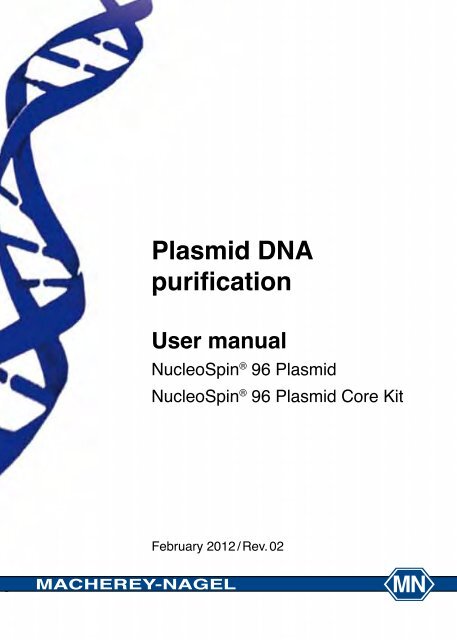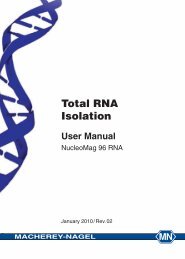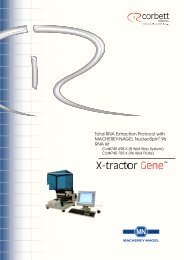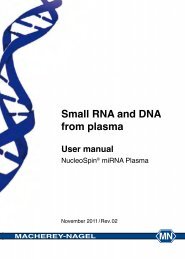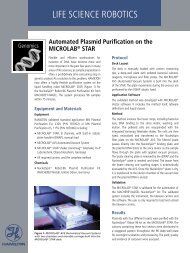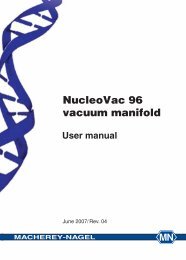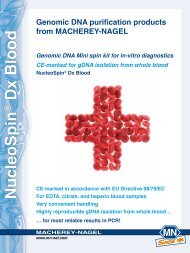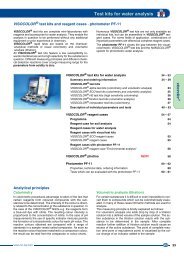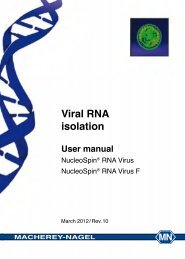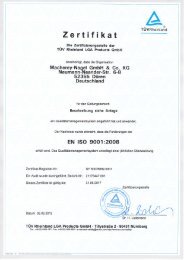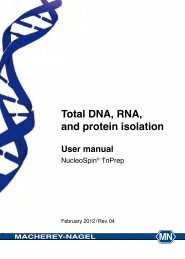Plasmid DNA purification - Macherey Nagel
Plasmid DNA purification - Macherey Nagel
Plasmid DNA purification - Macherey Nagel
Create successful ePaper yourself
Turn your PDF publications into a flip-book with our unique Google optimized e-Paper software.
<strong>Plasmid</strong> <strong>DNA</strong><br />
<strong>purification</strong><br />
User manual<br />
NucleoSpin ® 96 <strong>Plasmid</strong><br />
NucleoSpin ® 96 <strong>Plasmid</strong> Core Kit<br />
February 2012 / Rev. 02<br />
MACHEREY-NAGEL
<strong>Plasmid</strong> <strong>DNA</strong> <strong>purification</strong><br />
Table of contents<br />
1 Components 4<br />
1.1 Kit contents 4<br />
1.2 Reagents to be supplied by user 5<br />
2 Product description 6<br />
2.1 The basic principle 6<br />
2.2 Kit specifications 6<br />
2.3 Required hardware 7<br />
2.4 Recommended accessories for use of the NucleoSpin ® 96 <strong>Plasmid</strong><br />
Core Kit 8<br />
2.5 Automated processing on robotic platforms 9<br />
2.6 Growth of bacterial cultures 10<br />
2.6.1 Selection of culture media 10<br />
2.6.2 Cultivation of bacteria in a Square-well Block 10<br />
2.6.3 Cultivation of bacteria in tubes 10<br />
2.7 Elution procedures 11<br />
3 Storage conditions and preparation of working solutions 12<br />
4 Safety instructions – risk and safety phrases 13<br />
4.1 Risk and safety phrases 13<br />
4.2 GHS classification 14<br />
5 Protocols 16<br />
5.1 NucleoSpin ® 96 <strong>Plasmid</strong> – manual vacuum processing 16<br />
5.2 NucleoSpin ® 96 <strong>Plasmid</strong> – elution of <strong>DNA</strong> using a centrifuge 24<br />
6 Appendix 25<br />
6.1 Troubleshooting 25<br />
6.2 Ordering information 28<br />
6.4 Product use restriction / warranty 29<br />
MACHEREY-NAGEL – 02 / 2012, Rev. 02<br />
3
<strong>Plasmid</strong> <strong>DNA</strong> <strong>purification</strong><br />
1 Components<br />
1.1 Kit contents<br />
NucleoSpin ® 96 <strong>Plasmid</strong><br />
1 x 96 preps 4 x 96 preps 24 x 96 preps 1<br />
REF 740625.1 740625.4 740625.24<br />
Resuspension Buffer A1 50 mL 200 mL 6 x 200 mL<br />
Lysis Buffer A2 50 mL 200 mL 6 x 200 mL<br />
Neutralization Buffer A3 50 mL 200 mL 6 x 200 mL<br />
Wash Buffer AW 100 mL 400 mL 6 x 400 mL<br />
Wash Buffer A4 (Concentrate) 2 80 mL 2 x 160 mL 12 x 160 mL<br />
Elution Buffer AE 3 25 mL 2 x 100 mL 12 x 100 mL<br />
RNase A (lyophilized) 2 20 mg 80 mg 6 x 80 mg<br />
NucleoSpin ® <strong>Plasmid</strong> Binding<br />
Plate (transparent rings)<br />
NucleoSpin ® <strong>Plasmid</strong> Filter Plate<br />
(purple rings)<br />
Culture Plate (including Gaspermeable<br />
Foil)<br />
Elution Plate (including Selfadhering<br />
Foil)<br />
1 4 24<br />
1 4 24<br />
1 4 24<br />
1 4 24<br />
MN Wash Plate 1 4 24<br />
User manual 1 1 6<br />
1 The kit for 24 x 96 preparations (REF 740625.24) consists of 6 x REF 740625.4.<br />
2 For preparation of working solutions and storage conditions see section 3.<br />
3 Composition of Elution Buffer AE: 5 mM Tris/HCl, pH 8.5<br />
4<br />
MACHEREY-NAGEL – 02 / 2012, Rev. 02
<strong>Plasmid</strong> <strong>DNA</strong> <strong>purification</strong><br />
NucleoSpin ® 96 <strong>Plasmid</strong> Core Kit<br />
4 x 96 preps 24 x 96 preps 1<br />
REF 740616.4 740616.24<br />
Resuspension Buffer A1 200 mL 6 x 200 mL<br />
Lysis Buffer A2 200 mL 6 x 200 mL<br />
Neutralization Buffer A3 200 mL 6 x 200 mL<br />
Wash Buffer A4 Concentrate) 2 2 x 100 mL 12 x 100 mL<br />
Elution Buffer AE 3 2 x 50 mL 12 x 50 mL<br />
RNase A (lyophilized) 2 80 mg 6 x 80 mg<br />
NucleoSpin ® <strong>Plasmid</strong> Binding Plate<br />
(transparent rings)<br />
NucleoSpin ® <strong>Plasmid</strong> Filter Plate<br />
(purple rings)<br />
4 24<br />
4 24<br />
User manual 1 6<br />
1.2 Reagents to be supplied by user<br />
• 96–100 % ethanol<br />
1 The kit for 24 x 96 preparations (REF 740616.24) consists of 6 x REF 740616.4.<br />
2 For preparation of working solutions and storage conditions see section 3.<br />
3 Composition of Elution Buffer AE: 5 mM Tris/HCl, pH 8.5<br />
MACHEREY-NAGEL – 02 / 2012, Rev. 02<br />
5
<strong>Plasmid</strong> <strong>DNA</strong> <strong>purification</strong><br />
2 Product description<br />
2.1 The basic principle<br />
The NucleoSpin ® 96 <strong>Plasmid</strong> procedure is a modified version of the Birnboim and<br />
Doly 1 alkaline lysis plasmid Mini prep protocol. Bacterial cultures are harvested by an<br />
initial centrifugation step. After resuspension of the pelleted bacteria (Buffer A1) and<br />
alkaline cell lysis (Buffer A2), a neutralization and binding buffer (Buffer A3) containing<br />
chaotropic salts is added. Resulting bacterial crude lysates are cleared by vacuum<br />
filtration with the NucleoSpin ® <strong>Plasmid</strong> Filter Plate. The cleared lysates containing the<br />
plasmid <strong>DNA</strong> are collected into the NucleoSpin ® <strong>Plasmid</strong> Binding Plate. The chaotropic<br />
salt leads to a reversible adsorption of the plasmid <strong>DNA</strong> to the NucleoSpin ® silica<br />
membrane during the second vacuum-filtration step. High purity of the final plasmid<br />
<strong>DNA</strong> preparation is achieved by complete removal of cellular contaminants, salts,<br />
detergents, and other compounds by subsequent washing steps. Highly pure plasmid<br />
<strong>DNA</strong> is finally eluted with Elution Buffer AE (5 mM Tris / HCl, pH 8.5) or water (pH 8.0–<br />
8.5) and can directly be used for downstream applications.<br />
2.2 Kit specifications<br />
• NucleoSpin ® 96 <strong>Plasmid</strong> is designed for the manual or automated large-scale<br />
<strong>purification</strong> of high-copy plasmid <strong>DNA</strong> from E. coli in the 96-well plate format.<br />
• NucleoSpin ® 96 <strong>Plasmid</strong> kits (REF 740625.1 / .4 / .24) are supplied with all<br />
accessory plates for highest convenience.<br />
• The NucleoSpin ® 96 <strong>Plasmid</strong> Core Kit (REF 740616.4 / .24) provides the<br />
buffers, RNase A, NucleoSpin ® <strong>Plasmid</strong> Filter Plates, and NucleoSpin ® <strong>Plasmid</strong><br />
Binding Plates. Accessory components (e.g., culture plate, elution plate, MN<br />
Wash Plate, and Wash Buffer AW) are not provided with the core kit but can be<br />
individually selected from a variety of suitable accessories (see section 2.4 for<br />
further information). This allows highest flexibility for the user.<br />
Please note: All given specifications or information in this manual refer equally<br />
to the NucleoSpin ® 96 <strong>Plasmid</strong> kit (REF 740625.1 / .4 / .24) as well as to the<br />
NucleoSpin ® 96 <strong>Plasmid</strong> Core Kit (REF 740616.4 / .24).<br />
• The kits allow for easy automation on common liquid handling instruments. For<br />
more information about the automation process and the availability of ready-torun<br />
scripts for certain platforms please refer to section 2.5 and / or contact your<br />
local distributor or MN directly.<br />
• Using the NucleoSpin ® 96 <strong>Plasmid</strong> kits allow simultaneous manual processing<br />
of up to 96 samples typically within less than 45 minutes. Actual processing<br />
time depends on the configuration of the liquid handling system used.<br />
1 Birnboim, H.C. & Doly, J. (1979) Nucleic Acids Res. 7, 1513-1523.<br />
6<br />
MACHEREY-NAGEL – 02 / 2012, Rev. 02
<strong>Plasmid</strong> <strong>DNA</strong> <strong>purification</strong><br />
• Typically yields of 5–15 μg plasmid <strong>DNA</strong> can be purified from 1.5 mL overnight<br />
cultures.<br />
• Yield depends on copy number and plasmid size, selected culture medium, and<br />
bacterial host strain.<br />
• The <strong>DNA</strong> binding capacity is about 20 μg. The final concentration of the eluted<br />
<strong>DNA</strong> is 50–200 ng/μL (depending on the elution buffer volume and the bacterial<br />
culture).<br />
• Typically, the A 260 / A 280 ratio is > 1.8. Eluted <strong>DNA</strong> is ready to use for many<br />
downstream applications.<br />
Kit specifications at a glance<br />
Parameter<br />
Format<br />
Processing<br />
Lysate clarification<br />
Sample material<br />
Vector size<br />
Typical yield<br />
Elution volume<br />
Preparation time<br />
Binding capacity<br />
NucleoSpin ® 96 <strong>Plasmid</strong><br />
96-well plates<br />
Manual or automated, vacuum<br />
96-well filter plates<br />
1–5 mL E. coli culture<br />
< 15 kbp<br />
4–6 μg/mL E. coli culture<br />
75–150 μL<br />
45 min/plate<br />
20 μg<br />
2.3 Required hardware<br />
This kit is intended for use under vacuum. A support protocol for elution under<br />
centrifugation is included (see section 5.2).<br />
A support protocol for complete processing under centrifugation is available from our<br />
technical service (tech-bio@mn-net.com).<br />
The NucleoSpin ® 96 <strong>Plasmid</strong> kits can be used manually with the NucleoVac 96<br />
Vacuum Manifold (see ordering information). Additionally, a suitable centrifuge for<br />
harvesting the bacteria (either plate or tube centrifuge) and for the optimal elution step<br />
under centrifugation is required.<br />
MACHEREY-NAGEL – 02 / 2012, Rev. 02<br />
7
<strong>Plasmid</strong> <strong>DNA</strong> <strong>purification</strong><br />
2.4 Recommended accessories for use of the NucleoSpin ®<br />
96 <strong>Plasmid</strong> Core Kit<br />
The NucleoSpin ® 96 <strong>Plasmid</strong> Core Kit provides buffers (except optional Wash Buffer<br />
AW), RNase A, and NucleoSpin ® Filter / Binding Plates. Accessory plates (e.g., culture<br />
blocks, elution plates) are not provided with the core kit. The user can individually select<br />
additional consumables from a variety of suitable accessory plates according to his<br />
requirements for highest flexibility.<br />
For use of NucleoSpin ® 96 <strong>Plasmid</strong> Core Kit, follow the standard protocols (see<br />
section 5.1 or 5.2, respectively).<br />
Recommended accessories for use of the NucleoSpin ® 96 <strong>Plasmid</strong> Core Kit are<br />
available from MACHEREY-NAGEL. For ordering information, please refer to section<br />
6.2.<br />
Protocol<br />
step<br />
Cultivation of<br />
bacteria<br />
Suitable consumables, not<br />
supplied with the core kits<br />
Culture Plates<br />
Remarks<br />
Square-well Blocks with Gaspermeable<br />
Foil<br />
Wash step MN Wash Plates MN Wash Plate minimizes the risk<br />
of cross contamination (vacuum<br />
processing only)<br />
Elution<br />
Buffer AW<br />
Elution Plate<br />
U-bottom<br />
or<br />
Rack of Tube<br />
Strips (including<br />
Cap Strips)<br />
Recommended additional wash<br />
buffer for bacterial host strain with<br />
high endogenous nuclease activity<br />
(e.g., E. coli HB 101, BMH 71-18<br />
mutS, JM, or any wildtype strains)<br />
or for improvement of sequencing<br />
results<br />
Not suitable for elution by<br />
centrifugation<br />
8<br />
MACHEREY-NAGEL – 02 / 2012, Rev. 02
<strong>Plasmid</strong> <strong>DNA</strong> <strong>purification</strong><br />
2.5 Automated processing on robotic platforms<br />
NucleoSpin ® 96 <strong>Plasmid</strong> can be used fully automated on many common laboratory<br />
workstations. For the availability of scripts and general considerations about adapting<br />
NucleoSpin ® 96 <strong>Plasmid</strong> on a certain workstation, please contact MN. Full processing<br />
under vacuum enables complete automation without the need of centrifugation steps,<br />
regarding the drying of the binding membrane and elution step.<br />
The risk of cross-contamination is reduced by optimized vacuum settings during the<br />
elution step and by the improved shape of the outlets of the NucleoSpin ® <strong>Plasmid</strong><br />
Binding Plate.<br />
Drying of the NucleoSpin ® <strong>Plasmid</strong> Binding Plate under vacuum is sufficient because<br />
the bottom of the plate is protected from residues of wash buffer during the washing<br />
steps by the MN Wash Plate. As a result, we recommend trying to integrate the MN<br />
Wash Plate into the automated procedure. The MN Frame (see ordering information)<br />
can be used to position the disposable MN Wash Plate inside the vacuum chamber. This<br />
also reduces the risk of cross-contamination, as common metal adaptors tend to get<br />
contaminated by g<strong>DNA</strong>. Thorough cleaning of the vacuum chamber is recommended<br />
after each run to prevent forming of g<strong>DNA</strong>-containing aerosols.<br />
Visit MN online at www.mn-net.com or contact your local MACHEREY-NAGEL<br />
distributor for technical support regarding hardware, software, setup instructions, and<br />
selection of the protocol. Several application notes of the NucleoSpin ® 96 <strong>Plasmid</strong> kit<br />
on various liquid handling instruments can also be found at www.mn-net.com under<br />
Bioanalysis / Literature.<br />
MACHEREY-NAGEL – 02 / 2012, Rev. 02<br />
9
<strong>Plasmid</strong> <strong>DNA</strong> <strong>purification</strong><br />
2.6 Growth of bacterial cultures<br />
2.6.1 Selection of culture media<br />
The cultivation of cells is recommended at 37 °C in LB (Luria-Bertani) medium at constant<br />
shaking (200–250 rpm). Alternatively, rich media like 2 x YT or TB (Terrific Broth) can<br />
be used. By using 2 x YT or TB, bacteria grow faster and reach the stationary phase<br />
much earlier than in LB medium (≤ 12 h) in culture tubes or flasks. This may lead to a<br />
higher percentage of dead or starving cells when starting the preparation. The resulting<br />
plasmid <strong>DNA</strong> from overgrown cultures may be partially degraded or contaminated with<br />
chromosomal <strong>DNA</strong>.<br />
2.6.2 Cultivation of bacteria in a Square-well Block<br />
Use the 96-well Square-well Block (Culture Plate; not included in the core kits) for<br />
growing bacteria. Add 1.2–1.5 mL of selected medium (with appropriate antibiotic,<br />
e.g., 100 μg/mL ampicillin) to each well of the Square-well Block. To avoid crosscontamination<br />
due to spillage during incubation, do not exceed a total culture volume<br />
of 1.5 mL. Inoculate each well with a single bacterial colony. Cover the Square-well<br />
Block with the Gas-permeable Foil. Grow the culture in a suitable incubator at 37 °C for<br />
16–24 h with vigorous shaking (200–400 rpm). The Square-well Block may be fixed to<br />
the shaker with large-size flask clamps (for 2-L flasks) or tape.<br />
Note: The yield of plasmid <strong>DNA</strong> depends on growth conditions, bacterial strain, and<br />
cell density of the culture as well as on the size and copy number of the vector. Use of<br />
high-copy number plasmids such as pUC, pBluescript, or pGEM and E. coli strains like<br />
DH5α or XL1 Blue are recommended. Growth times of 16–24 h are usually sufficient.<br />
However, for poorly growing bacteria, prolonged incubation times of up to 30 h may be<br />
required.<br />
2.6.3 Cultivation of bacteria in tubes<br />
Use 1–5 mL of appropriate culture medium. Depending on the bacterial strain and copy<br />
number of the plasmid, up to 5 mL LB medium or 2.5 mL 2 x YT or 2.5 mL TB medium<br />
can be used. Grow bacteria with vigorous shaking (200–250 rpm) for 10–14 h.<br />
Optional: If the liquid handling instrument does not allow for the use of selected culture<br />
tubes, transfer the bacterial culture from the tubes into a suitable Square-well Block.<br />
For this, transfer 1.5 mL of the culture to each well of the Square-well Block. Harvest the<br />
cultures by centrifugation. Discard supernatant. Usually 1.5 mL of culture are sufficient<br />
for <strong>DNA</strong> preparation. However, if necessary, add additional 1.0–1.5 mL bacterial culture<br />
to each well of the Square-well Block, centrifuge again, and discard the supernatant.<br />
Do not use more than 5 mL LB culture or 2.5 mL rapid growing bacterial strain (using<br />
2 x YT or TB medium) because lysis efficiency might be lower when using cell pellets<br />
which are too large.<br />
10<br />
MACHEREY-NAGEL – 02 / 2012, Rev. 02
<strong>Plasmid</strong> <strong>DNA</strong> <strong>purification</strong><br />
2.7 Elution procedures<br />
See the following table for correlation between the dispensed elution buffer volume and<br />
typical recoveries following the standard protocol under vacuum.<br />
The recommended dispense volume of elution buffer is 125 μL.<br />
Correlation between dispensed elution buffer volume and typical recovery<br />
Dispensed elution buffer 75 μL 100 μL 125 μL 150 μL 175 μL<br />
Recovered elution buffer<br />
containing PCR-products<br />
30 ± 5 μL 55 ± 5 μL 80 ± 5 μL 105 ± 5 μL 130 ± 5 μL<br />
Recovered <strong>DNA</strong>, µg<br />
Concentration, ng/µL<br />
Recovery, %<br />
Concentration, ng/µL<br />
Recovered <strong>DNA</strong>, µg<br />
Recovery, %<br />
Dispensed elution buffer, µL<br />
Recovered elution buffer, µL<br />
Figure 1: Recovery rate and concentration depend on elution volume.<br />
10 μg of pBluescript pasmid were purified with NucleoSpin ® 96 <strong>Plasmid</strong> and eluted with<br />
the indicated elution buffer volumes.<br />
MACHEREY-NAGEL – 02 / 2012, Rev. 02<br />
11
<strong>Plasmid</strong> <strong>DNA</strong> <strong>purification</strong><br />
3 Storage conditions and preparation of working<br />
solutions<br />
Attention: Buffers A3 and AW contain chaotropic salts which are irritant. Buffer A2<br />
contains SDS and sodium hydroxide which are irritant and hazardous. Wear gloves<br />
and goggles!<br />
CAUTION: Buffers A3 and AW contain guanidine hydrochloride which can form highly<br />
reactive compounds when combined with bleach (sodium hypochlorite). DO NOT add<br />
bleach or acidic solutions directly to the sample-preparation waste.<br />
Storage conditions:<br />
• All kit components can be stored at room temperature (18–25 °C) and are<br />
stable up to one year. Always keep buffer bottles tightly closed, especially if<br />
buffers are preheated during the preparation. Sodium dodecyl sulfate (SDS) in<br />
Buffer A2 may precipitate if stored at temperatures below 20 °C. If a precipitate<br />
is observed in Buffer A2, incubate the bottle at 30–40 °C for several minutes<br />
and mix well.<br />
Before starting any NucleoSpin ® 8 <strong>Plasmid</strong> protocol, prepare the following:<br />
• Before the first use of the kit, add 1 mL of Buffer A1 to the RNase A vial and<br />
vortex. Transfer all of the resulting solution into the Buffer A1 bottle and mix<br />
thoroughly. Indicate date of RNase A addition. Store Buffer A1 containing<br />
RNase A at 4 °C. The solution will be stable at this temperature for at least six<br />
months.<br />
• Wash Buffer A4: Add the indicated volume of ethanol (96–100 %) to Buffer<br />
A4 Concentrate before use. Mark the label of the bottle to indicate that ethanol<br />
was added.<br />
NucleoSpin ® 96 <strong>Plasmid</strong><br />
1 x 96 preps 4 x 96 preps 24 x 96 preps<br />
REF 740625.1 740625.4 740625.24<br />
Wash Buffer A4<br />
(Concentrate)<br />
80 mL<br />
Add 320 mL ethanol<br />
2 x 160 mL<br />
Add 640 mL ethanol<br />
to each bottle<br />
12 x 160 mL<br />
Add 640 mL ethanol<br />
to each bottle<br />
NucleoSpin ® 96 <strong>Plasmid</strong> Core Kit<br />
4 x 96 preps 24 x 96 preps<br />
REF 740616.4 740616.24<br />
Wash Buffer A4<br />
(Concentrate)<br />
12<br />
2 x 100 mL<br />
Add 400 mL ethanol<br />
to each bottle<br />
MACHEREY-NAGEL – 02 / 2012, Rev. 02<br />
12 x 100 mL<br />
Add 400 mL ethanol<br />
to each bottle
<strong>Plasmid</strong> <strong>DNA</strong> <strong>purification</strong><br />
4 Safety instructions – risk and safety phrases<br />
4.1 Risk and safety phrases<br />
The following components of the NucleoSpin ® 96 <strong>Plasmid</strong> and the NucleoSpin ® 96<br />
<strong>Plasmid</strong> Core Kits contain hazardous contents. Wear gloves and goggles and follow<br />
the safety instructions given in this section.<br />
Component Hazard contents Hazard<br />
symbol<br />
Inhalt Gefahrstoff Gefahrstoffsymbol<br />
Risk<br />
phrases<br />
R-Sätze<br />
Safety<br />
phrases<br />
S-Sätze<br />
A2 Sodium hydroxide 0.5–2.0 % Xi* R 36/38 S 26-<br />
Natriumhydroxid-Lösung 0.5–2.0 %<br />
37/39-45<br />
A3 Guanidine hydrochloride 36–50 % Xn** R 22-36 S 26-39<br />
Guanidinhydrochlorid 36–50 %<br />
AW<br />
Guanidine hydrochloride<br />
36–50 % + isopropanol 20–50 %<br />
Guanidinhydrochlorid 36–50 % +<br />
Isopropanol 20–50 %<br />
X** R 10-22-36 S 16-26-<br />
39<br />
RNase A RNase A, lyophilized Xn R 42/43 S 22-24<br />
RNase A, lyophilisiert<br />
Risk phrases<br />
R 10 Flammable.<br />
Entzündlich.<br />
R 22 Harmful if swallowed.<br />
Gesundheitsschädlich beim Verschlucken.<br />
R 36 Irritating to eyes.<br />
Reizt die Augen.<br />
R 36/38 Irritating to eyes and skin<br />
Reizt die Augen und die Haut.<br />
R 42/43 May cause sensitization by inhalation and skin contact<br />
Sensibilisierung durch Einatmen und Hautkontakt möglich.<br />
Safety phrases<br />
S 16 Keep away from sources of ignition – No smoking.<br />
Von Zündquellen fernhalten.<br />
S 22 Do not breathe dust.<br />
Staub nicht einatmen.<br />
S 24 Avoid contact with the skin.<br />
Berührung mit der Haut vermeiden.<br />
* Hazard labeling not necessary if quantity per bottle below 25 g or mL (certificate of exemption<br />
according to 67/548/EEC Art. 25, 1999/45/EC Art. 12 and German GefStoffV § 20 (3) and TRGS 200 7.1).<br />
For further information see Material Safety Data Sheet.<br />
** Hazard labeling not necessary if quantity per bottle below 125 g or mL (certificate of exemption<br />
according to 67/548/EEC Art. 25, 1999/45/EC Art. 12 and German GefStoffV § 20 (3) and TRGS 200 7.1).<br />
For further information see Material Safety Data Sheet.<br />
MACHEREY-NAGEL – 02 / 2012, Rev. 02<br />
13
<strong>Plasmid</strong> <strong>DNA</strong> <strong>purification</strong><br />
Safety phrases<br />
S 26<br />
S 37/39<br />
S 39<br />
S 45<br />
In case of contact with eyes, rinse immediately with plenty of water and seek<br />
medical advice.<br />
Bei Berührung mit den Augen gründlich mit Wasser abspülen und Arzt konsultieren.<br />
Wear suitable gloves and eye / face protection.<br />
Bei der Arbeit geeignete Schutzhandschuhe und Schutzbrille / Gesichtsschutz tragen.<br />
Wear eye / face protection.<br />
Schutzbrille / Gesichtsschutz tragen.<br />
In case of accident or if you feel unwell seek medical advice immediately (show<br />
the label where possible).<br />
Bei Unfall oder Unwohlsein sofort Arzt zuziehen (wenn möglich dieses Etikett vorzeigen).<br />
4.2 GHS classification<br />
Only harmful features do not need to be labeled with H and P phrases until 125 mL or<br />
125 g.<br />
Mindergefährliche Eigenschaften müssen bis 125 mL oder 125 g nicht mit H- und P-Sätzen gekennzeichnet<br />
werden.<br />
Component Hazard contents GHS symbol Hazard<br />
phrases<br />
Precaution<br />
phrases<br />
Inhalt Gefahrstoff GHS Symbol H-Sätze P-Sätze<br />
A2<br />
A3<br />
AW<br />
Sodium hydroxide<br />
0.5–2.0 %<br />
Natriumhydroxid-Lösung<br />
0.5–2.0 %<br />
Guanidine hydrochloride<br />
36–50 %<br />
Guanidinhydrochlorid 36–50 %<br />
Guanidinium thiocyanate<br />
36–50 % + isopropanol<br />
20–50 %<br />
Guanidiniumthiocyanat 36–<br />
50 % + Isopropanol 20–50 %<br />
Warning<br />
Achtung<br />
315, 319 280, 302+352,<br />
305+351+338,<br />
332+313,<br />
337+313<br />
Warning 302, 319 280, 301+312,<br />
305+351+338,<br />
Achtung<br />
330, 337+313<br />
Warning 226, 302,<br />
319<br />
Achtung<br />
210, 233, 280,<br />
301+312,<br />
305+351+338,<br />
330, 337+313,<br />
403+235<br />
RNase A RNase A, lyophilized Danger 317, 334 261, 280,<br />
RNase A, lyophilisiert<br />
Gefahr<br />
302+352,<br />
304+341,<br />
333+313,<br />
342+311, 363<br />
Hazard phrases<br />
H 226<br />
Flammable liquid and vapour.<br />
Flüssigkeit und Dampf entzündbar.<br />
H 302<br />
Harmful if swallowed.<br />
Gesundheitsschädlich bei Verschlucken.<br />
H 315<br />
Causes skin irritation.<br />
Verursacht Hautreizungen.<br />
14<br />
MACHEREY-NAGEL – 02 / 2012, Rev. 02
<strong>Plasmid</strong> <strong>DNA</strong> <strong>purification</strong><br />
Hazard phrases<br />
H 317<br />
H 319<br />
H 334<br />
May cause an allergic skin reaction.<br />
Kann allergische Hautreaktionen verursachen.<br />
Causes serious eye irritation.<br />
Verursacht schwere Augenreizung.<br />
May cause allergy or asthma symptoms or breathing difficulties if inhaled.<br />
Kann bei Einatmen Allergie, asthmaartige Symptome oder Atembeschwerden verursachen.<br />
Precaution phrases<br />
P 210<br />
Keep away from heat/sparks/open flames/hot surfaces – No smoking.<br />
Von Hitze / Funken / offener Flamme / heißen Oberflächen fernhalten. Nicht rauchen.<br />
P 233<br />
Keep container tightly closed.<br />
Behälter dicht verschlossen halten.<br />
P 261<br />
Avoid breathing dust.<br />
Einatmen von Staub vermeiden.<br />
P 280<br />
Wear protective gloves / eye protection.<br />
Schutzhandschuhe / Augenschutz tragen.<br />
P 301+312 IF SWALLOWED: Call a POISON CENTER or doctor /physician if you feel<br />
unwell.<br />
BEI VERSCHLUCKEN: Bei Unwohlsein GIFTINFORMATIONSZENTRUM oder Arzt<br />
anrufen.<br />
P 302+352 IF ON SKIN: Wash with plenty of soap and water.<br />
BEI KONTAKT MIT DER HAUT: Mit viel Wasser und Seife waschen.<br />
P 304+341 IF INHALED: If breathing is difficult, remove to fresh air and keep at rest in a<br />
position comfortable for breathing.<br />
Bei Einatmen: Bei Atembeschwerden an die frische Luft bringen und in einer Position<br />
ruhigstellen, die das Atmen erleichtert.<br />
P 305+351+338 IF IN EYES: Rinse continuously with water for several minutes. Remove<br />
contact lenses if present and easy to do – continue rinsing.<br />
BEI KONTAKT MIT DEN AUGEN: Einige Minuten lang behutsam mit Wasser spülen.<br />
Vorhandene Kontaktlinsen nach Möglichkeit entfernen. Weiter spülen.<br />
P 330<br />
Rinse mouth.<br />
Mund ausspülen.<br />
P 332+313 If skin irritation occurs: Get medical advice / attention.<br />
Bei Hautreizung: Ärztlichen Rat einholen / ärztliche Hilfe hinzuziehen.<br />
P 333+313 If skin irritation occurs: Get medical advice / attention.<br />
Bei Hautreizung- oder -ausschlag: Ärztlichen Rat einholen / ärztliche Hilfe hinzuziehen.<br />
P 337+313 Get medical advice / attention.<br />
Bei anhaltender Augenreizung: Ärztlichen Rat einholen / ärztliche Hilfe hinzuziehen.<br />
P 342+311 If experiencing respiratory symptoms: Call a POISON CENTER or doctor<br />
/ physician.<br />
Bei Symptomen der Atemwege: Giftinformationszentrum oder Arzt anrufen.<br />
P 363<br />
Wash contaminated clothing before reuse.<br />
Kontaminierte Kleidung vor erneutem Tragen waschen.<br />
P 403+235 Store in a well ventilated place. Keep cool.<br />
Kühl an einem gut belüfteten Ort aufbewahren.<br />
For further information please see Material Safety Data Sheets (www.mn-net.com).<br />
Weiterführende Informationen finden Sie in den Sicherheitsdatenblättern (www.mn-net.com).<br />
MACHEREY-NAGEL – 02 / 2012, Rev. 02<br />
15
NucleoSpin ® 96 <strong>Plasmid</strong> – manual vacuum processing<br />
5 Protocols<br />
5.1 NucleoSpin ® 96 <strong>Plasmid</strong> – manual vacuum processing<br />
• For hardware requirements, refer to section 2.3.<br />
• For detailed information regarding the vacuum manifold setup, see page 18–19.<br />
• For detailed information on each step, see page 20.<br />
• For use of the NucleoSpin ® 96 <strong>Plasmid</strong> Core Kit (REF 740616.4 / .24), refer to<br />
section 2.4 regarding recommended accessories.<br />
Before starting the preparation:<br />
• Check if Buffer A1 and Buffer A4 were prepared according to section 3.<br />
• Set up the vacuum according to the sheme.<br />
Protocol-at-a-glance<br />
1 Cultivate and harvest bacterial cells 1.5 mL–5 mL LB or<br />
up to 2.5 mL 2 x YT or TB<br />
10 min,<br />
1,000 x g<br />
2 Resuspend bacterial cells 250 μL A1<br />
Mix or shake<br />
3 Lyse bacterial cells 250 μL A2<br />
RT, 2–5 min<br />
Shake<br />
4 Neutralize 350 μL A3<br />
Mix or shake<br />
Prepare vacuum manifold<br />
for lysate clearing step<br />
5 Transfer crude lysates to NucleoSpin ®<br />
<strong>Plasmid</strong> Filter Plate (purple rings)<br />
16<br />
MACHEREY-NAGEL – 02 / 2012, Rev. 02
NucleoSpin ® 96 <strong>Plasmid</strong> – manual vacuum processing<br />
6 Clear crude lysates by vacuum filtration<br />
directly into the NucleoSpin ® <strong>Plasmid</strong><br />
Binding Plate (transparent rings)<br />
-0.2 to -0.4 bar*,<br />
1–5 min<br />
Optional: Incubate 1–3 min before applying<br />
vacuum<br />
7 Reassemble vacuum manifold<br />
Discard NucleoSpin ® <strong>Plasmid</strong> Filter Plate<br />
Remove NucleoSpin ® <strong>Plasmid</strong> Binding Plate<br />
with cleared lysates and insert MN Wash Plate<br />
Place NucleoSpin ® <strong>Plasmid</strong> Binding Plate on<br />
top of the manifold<br />
8 Bind <strong>DNA</strong> to silica membrane of the<br />
NucleoSpin ® <strong>Plasmid</strong> Binding Plate by<br />
applying vacuum<br />
-0.2 to -0.4 bar*,<br />
1 min<br />
9 Wash silica membrane (Optional: 600 μL AW)<br />
900 μL A4<br />
900 μL A4<br />
-0.2 to -0.4 bar*,<br />
1 min each step<br />
10 Remove MN Wash Plate<br />
11 Dry NucleoSpin ® <strong>Plasmid</strong> Binding Plate<br />
by applying vacuum<br />
Optional: Dry the outlets of the NucleoSpin ®<br />
<strong>Plasmid</strong> Binding Plate by placing it on a<br />
sheet of filter paper before applying vacuum<br />
Full vacuum<br />
10–15 min<br />
(run pump continuously)*<br />
12 Insert Elution Plate U-bottom<br />
13 Elute plasmid <strong>DNA</strong><br />
Optional: Incubate 1–3 min<br />
75–150 μL AE<br />
-0.4 to -0.6 bar*,<br />
1 min<br />
* Reduction of atmospheric pressure<br />
MACHEREY-NAGEL – 02 / 2012, Rev. 02<br />
17
NucleoSpin ® 96 <strong>Plasmid</strong> – manual vacuum processing<br />
Setup of vacuum manifold: Lysate clearing<br />
Lysate clearing<br />
Step 4:<br />
Place the NucleoSpin ® Filter Plate<br />
on top of the manifold<br />
Step 3:<br />
Place the manifold lid on top of the<br />
manifold base.<br />
Step 2:<br />
Place the NucleoSpin ® Binding Plate<br />
into the manifold.<br />
Step 1:<br />
Insert spacers`MTP/Multi-96 Plate‘<br />
in the manifold base.<br />
Final setup<br />
18<br />
MACHEREY-NAGEL – 02 / 2012, Rev. 02
NucleoSpin ® 96 <strong>Plasmid</strong> – manual vacuum processing<br />
Setup of vacuum manifold: Binding / Washing / Elution steps<br />
Binding / Washing steps<br />
Elution step<br />
Step 4:<br />
Place the NucleoSpin ®<br />
Binding Plate on top of<br />
the manifold lid.<br />
Step 4:<br />
Place the NucleoSpin ®<br />
Binding Plate on top of<br />
the manifold lid.<br />
Step 3:<br />
Place the manifold lid on<br />
top of the manifold base.<br />
Step 3:<br />
Place the manifold lid on<br />
top of the manifold base.<br />
Step 2:<br />
Place the MN Wash Plate<br />
in the manifold.<br />
Step 2:<br />
Place the Elution Plate<br />
in the manifold.<br />
Step 1:<br />
Insert spacers<br />
`MTP/Multi-96 Plate‘<br />
in the manifold base.<br />
Step 1:<br />
Insert spacers<br />
`MTP/Multi-96 Plate‘<br />
in the manifold base.<br />
Final setup<br />
Final setup<br />
MACHEREY-NAGEL – 02 / 2012, Rev. 02<br />
19
NucleoSpin ® 96 <strong>Plasmid</strong> – manual vacuum processing<br />
Detailed protocol<br />
For processing of NucleoSpin ® 96 <strong>Plasmid</strong> under vacuum the NucleoVac 96 Vacuum<br />
Manifold is required.<br />
Before starting the preparation:<br />
• Check if Buffer A1 and Buffer A4 were prepared according to section 3.<br />
1 Cultivate and harvest bacterial cells<br />
Centrifuge the bacteria cultures (1.5–5 mL LB or up to 2.5 mL 2 x YT or TB) for<br />
10 min at 1,000 x g.<br />
It is highly recommended centrifuging the bacterial cultures under the above<br />
mentioned conditions. Centrifugation at higher g-forces might produce tight<br />
pellets which are more difficult to resuspend.<br />
Discard supernatant. Remove residual medium by tapping tube or plate upside<br />
down on a clean paper sheet or soft tissue.<br />
Optional: Transfer bacteria cultures grown in tubes to a Square-well Block. Alternatively,<br />
perform the next three steps in the tubes.<br />
2 Resuspend bacterial cells<br />
Add 250 μL Buffer A1 with RNase A to each sample. Resuspend the bacterial<br />
pellet by vortexing or mixing by pipetting up and down. Resuspend bacterial cells<br />
completely. No clumps should be visible.<br />
3 Lyse bacterial cells<br />
Add 250 μL Buffer A2 to the suspension. (For lysis in tubes: close the culture<br />
tube and mix by inverting several times.)<br />
Incubate at room temperature (18–25 °C) for a maximum of 5 min with moderate<br />
shaking (300 rpm).<br />
Note: Do not vortex; doing so will release contaminating chromosomal <strong>DNA</strong> from the<br />
cellular debris into the suspension. Do not allow the lysis reaction to proceed for more<br />
than 5 minutes.<br />
20<br />
MACHEREY-NAGEL – 02 / 2012, Rev. 02
NucleoSpin ® 96 <strong>Plasmid</strong> – manual vacuum processing<br />
4 Neutralize<br />
Add 350 μL Buffer A3 to the suspension. (For lysis in tubes: close the culture<br />
tube and mix by inverting several times. For lysis in plates: either mix by pipetting<br />
up and down after addition of Buffer A3 or before loading to NucleoSpin ® <strong>Plasmid</strong><br />
Filter Plate.)<br />
Optional: Incubate on ice for 5 min for optimal formation of precipitate.<br />
Prepare the NucleoVac 96 Vacuum Manifold<br />
Prepare manifold for filtration of crude lysates (see page 18):<br />
Insert spacers labeled ‘MTP/Multi-96 Plate’ notched side up into the grooves<br />
located on the short sides of the manifold base. Insert waste container into<br />
manifold base. Place the NucleoSpin ® <strong>Plasmid</strong> Binding Plate (transparent rings)<br />
on top of the spacers. Insert NucleoSpin ® <strong>Plasmid</strong> Filter Plate (purple rings) into<br />
the manifold lid and place the lid on the manifold base. Close the manifold base<br />
with the manifold lid. Close the vacuum manifold’s valve<br />
5 Transfer crude lysates onto the NucleoSpin ® <strong>Plasmid</strong> Filter Plate<br />
Transfer the crude lysates resulting from step 4 carefully and completely into the<br />
wells of the NucleoSpin ® <strong>Plasmid</strong> Filter Plate.<br />
Note: Mix the suspension by pipetting up and down the entire volume once before<br />
transfer to the NucleoSpin ® <strong>Plasmid</strong> Filter Plate.<br />
6 Clear crude lysate by vacuum filtration<br />
Apply vacuum of -0.2 to -0.4 bar* (1–5 min). If necessary, press down the<br />
NucleoSpin ® <strong>Plasmid</strong> Filter Plate slightly until flow through starts. Adjust vacuum<br />
to establish a flow rate of 1–2 drops per second.<br />
When the crude lysate has passed the NucleoSpin ® <strong>Plasmid</strong> Filter Plate, release<br />
the vacuum.<br />
7 Reassemble vacuum manifold<br />
Remove and discard the NucleoSpin ® <strong>Plasmid</strong> Filter Plate. Open the manifold lid.<br />
Remove the NucleoSpin ® <strong>Plasmid</strong> Binding Plate (transparent rings) with cleared<br />
lysates.<br />
Insert the MN Wash Plate on the spacers inside the manifold base (see page 19).<br />
Close the manifold base with the manifold lid. Place the Binding Plate on top of<br />
the manifold.<br />
* Reduction of atmospheric pressure<br />
MACHEREY-NAGEL – 02 / 2012, Rev. 02<br />
21
NucleoSpin ® 96 <strong>Plasmid</strong> – manual vacuum processing<br />
8 Bind <strong>DNA</strong> to silica membrane<br />
Apply vacuum of -0.2 to -0.4 bar* (1 min). If necessary, press down the<br />
NucleoSpin ® <strong>Plasmid</strong> Binding Plate slightly until flow through starts. Adjust<br />
vacuum to establish a flow rate of 1–2 drops per second.<br />
When the cleared lysate has drained off, release the vacuum.<br />
9 Wash silica membrane<br />
1 st wash (optional)<br />
Add 600 μL Buffer AW to each well. Apply vacuum of -0.2 to -0.4 bar* (1 min). If<br />
necessary, press down the NucleoSpin ® <strong>Plasmid</strong> Binding Plate slightly. Allow the<br />
buffer to pass the wells.<br />
Release the vacuum.<br />
Note: This additional wash step is recommended if the bacterial host strain has a high<br />
endogenous nuclease activity (e.g., E. coli HB 101, BMH 71-18 mutS, JM, or any wildtype<br />
strains) or if sequencing results need to be improved.<br />
2 nd wash<br />
Add 900 μL Buffer A4 (with ethanol) to each well. Apply vacuum of -0.2 to<br />
-0.4 bar* (1 min) and allow the buffer to pass the wells.<br />
Release the vacuum.<br />
3 rd wash<br />
Repeat the wash step with 900 μL Buffer A4. Apply vacuum of -0.2 to -0.4 bar*<br />
(1 min) and allow the buffer to pass the wells.<br />
Release the vacuum.<br />
10 Remove MN Wash Plate<br />
After the final washing step, close the valve, release the vacuum, and remove the<br />
NucleoSpin ® <strong>Plasmid</strong> Binding Plate. Remove manifold lid, MN Wash Plate, and<br />
waste container from the vacuum manifold.<br />
* Reduction of atmospheric pressure<br />
22<br />
MACHEREY-NAGEL – 02 / 2012, Rev. 02
NucleoSpin ® 96 <strong>Plasmid</strong> – manual vacuum processing<br />
11 Dry NucleoSpin ® <strong>Plasmid</strong> Binding Plate<br />
Remove any residual wash buffer from the NucleoSpin ® <strong>Plasmid</strong> Binding Plate. If<br />
necessary, tap the outlets of the plate onto a clean paper sheet (supplied with the<br />
MN Wash Plate) or soft tissue until no drops come out.<br />
Close the manifold base with the manifold lid. Place the NucleoSpin ® Binding<br />
Plate on top of the manifold.<br />
Apply vacuum of -0.4 to -0.6 bar* for at least 10–15 min to dry the membrane<br />
completely. Run vacuum pump continuously. Typically, the adjusted vacuum is<br />
not reached at this step. Achieving and keeping a continuous air-flow in order to<br />
evaporate the remaining ethanol from Wash Buffer A4 is of more importance than<br />
reaching the precise mentioned atmospheric pressure.<br />
Note: The ethanol in Buffer A4 inhibits enzymatic reactions and has to be completely<br />
removed before eluting the <strong>DNA</strong>.<br />
Finally, release the vacuum.<br />
12 Insert Elution Plate U-bottom<br />
Remove the manifold lid with the NucleoSpin ® <strong>Plasmid</strong> Binding Plate from the<br />
vacuum manifold. Insert the Elution Plate on the spacers inside the manifold<br />
base. Close the manifold base with the manifold lid. Place the NucleoSpin ®<br />
<strong>Plasmid</strong> Binding Plate (transparent rings) on top of the manifold.<br />
For elution into microtiter plates, spacers ‘MTP/Multi-96 Plate’ are required which<br />
are already inserted into the manifold base from the previous steps.<br />
13 Elute plasmid <strong>DNA</strong><br />
Elute the <strong>DNA</strong> by adding 125 μL Buffer AE (5 mM Tris-HCl, pH 8.5; 125 μL<br />
is recommended, a volume range of 75–150 μL is possible, see section 2.7)<br />
or sterile distilled water (pH 7.5–8.5) to each well of the NucleoSpin ® <strong>Plasmid</strong><br />
Binding Plate.<br />
The elution buffer should be dispensed carefully onto the center of the silica<br />
membrane. Incubate the buffer on the membrane for 1–3 minutes at room<br />
temperature. Apply vacuum of -0.4 to -0.6 bar* (1 min). If necessary, press down<br />
the NucleoSpin ® <strong>Plasmid</strong> Binding Plate slightly and collect the eluted <strong>DNA</strong>. After<br />
the elution buffer has passed the wells, release vacuum.<br />
Remove the Elution Plate U-bottom containing eluted <strong>DNA</strong> and seal the strips /<br />
plate with adhesive cover foil or Cap Strips, respectively, for further storage.<br />
* Reduction of atmospheric pressure<br />
MACHEREY-NAGEL – 02 / 2012, Rev. 02<br />
23
NucleoSpin ® 96 <strong>Plasmid</strong> – elution of <strong>DNA</strong> using a centrifuge<br />
5.2 NucleoSpin ® 96 <strong>Plasmid</strong> – elution of <strong>DNA</strong> using a<br />
centrifuge<br />
Elution of purified <strong>DNA</strong> in a centrifuge can be performed be necessary when higher<br />
concentrations of the final <strong>DNA</strong> are required for downstream applications. Using a<br />
centrifuge allows the dispensed volume to be reduced down to 50–75 μL.<br />
Required hardware:<br />
• For centrifugation, a microtiterplate centrifuge that can accommodate the<br />
NucleoSpin ® <strong>Plasmid</strong> Binding Plate stacked on a rack of Tube Strips is required<br />
(bucket height: 85 mm). It is also necessary that the centrifuge reaches<br />
accelerations of 5,600–6,000 x g.<br />
• Suitable elution tubes: Rack of Tube Strips have to be ordered separately (see<br />
ordering information).<br />
1 Stop the method after the final washing step with Buffer A4. Remove the<br />
NucleoSpin ® <strong>Plasmid</strong> Binding Plate from the manifold´s top and tap on a sheet of<br />
filter paper to remove residual wash buffer from the outlets.<br />
2 Place the NucleoSpin ® <strong>Plasmid</strong> Binding Plate on top of a MN Square-well Block<br />
(not included in the kits, see ordering information) and centrifuge for 10 min at<br />
maximum speed (> 4,000 x g, optimal 5,800 x g).<br />
Note: Do not use a microtiter plate as a support for the NucleoSpin ® <strong>Plasmid</strong> Binding<br />
Plate. Microtiter plates may crack under centrifugation at > 1,500 x g.<br />
3 Place the NucleoSpin ® <strong>Plasmid</strong> Binding Plate on top of a Rack of Tube Strips.<br />
Dispense Elution Buffer AE (50–150 μL) directly onto the silica membrane and<br />
incubate for 1–3 min at room temperature.<br />
Note: Do not use a microtiter plate as elution plate. Microtiter plates may crack under<br />
centrifugation at > 1,500 x g. Alternatively, a 96-well PCR plate can be inserted into the<br />
Square-well Block for elution.<br />
4 Centrifuge for 2 min at maximum speed (> 4,000 x g, optimal 5,800 x g) to<br />
collect the plasmid <strong>DNA</strong>.<br />
Remove the Rack of Tube Strips containing eluted <strong>DNA</strong> and close them with Cap<br />
Strips for further storage.<br />
24<br />
MACHEREY-NAGEL – 02 / 2012, Rev. 02
<strong>Plasmid</strong> <strong>DNA</strong> <strong>purification</strong><br />
6 Appendix<br />
6.1 Troubleshooting<br />
Problem<br />
Possible cause and suggestions<br />
Cell pellet not properly resuspended<br />
• It is essential that the cell pellet is completely resuspended prior<br />
to lysis. No cell clumps should be visible before addition of Lysis<br />
Buffer A2. If necessary, increase number of mixing cycles or<br />
duration of shaking.<br />
Incomplete<br />
lysis of<br />
bacterial<br />
cells<br />
SDS in Buffer A2 precipitated<br />
• SDS in Buffer A2 may precipitate upon storage. If this happens,<br />
a white precipitate is visible at the bottom of the bottle. Incubate<br />
Buffer A2 at 30–40 °C for 5 min and mix well before use.<br />
Too many bacterial cells used<br />
• Usage of LB as the growth medium is recommended. When<br />
using rich media like TB, cultures reach very high cell densities.<br />
Reduce culture volume to 1.0–1.5 mL.<br />
No or not enough antibiotic used during cultivation<br />
• Cells harboring the plasmid of interest may become overgrown<br />
by non-transformed cells. Add appropriate amounts of freshly<br />
prepared stock solutions of antibiotic to all media.<br />
Overgrown bacterial cultures<br />
• See suggestions in section 2.6 ‘Growth of bacterial cultures’.<br />
Poor<br />
plasmid<br />
yield<br />
High-copy number plasmid was not used<br />
• Use high-copy number plasmid.<br />
Incomplete lysis of bacterial cells<br />
• See ‘Possible cause and suggestions’ above.<br />
No ethanol was added to Buffer A4 Concentrate, ethanol evaporated<br />
• Add indicated volume of ethanol to Buffer A4 Concentrate and<br />
mix. Keep bottle tightly closed to prevent evaporation of ethanol.<br />
MACHEREY-NAGEL – 02 / 2012, Rev. 02<br />
25
<strong>Plasmid</strong> <strong>DNA</strong> <strong>purification</strong><br />
Problem<br />
Poor<br />
plasmid<br />
yield<br />
(continued)<br />
Possible cause and suggestions<br />
Elution conditions are not optimal<br />
• If possible, use a slightly alkaline elution buffer like Buffer AE<br />
(5 mM Tris-HCl, pH 8.5). When using nuclease-free water for<br />
elution, make sure the pH value is within the range of pH 8.0–<br />
8.5. Elution efficiencies drop drastically at pH < 7.<br />
Excessive mixing steps<br />
• Reduce number of mixing cycles, reduce shaker action after<br />
addition of Lysis Buffer A2 and Neutralization Buffer A3 or before<br />
transfer of crude lysate to the NucleoSpin ® <strong>Plasmid</strong> Filter Strips.<br />
Mixing will cause shearing of chromosomal <strong>DNA</strong>, leading to a<br />
co-<strong>purification</strong> during the preparation of plasmid <strong>DNA</strong>.<br />
Contamination<br />
with<br />
chromosomal<br />
<strong>DNA</strong><br />
Culture volume was too high<br />
• Reduce culture volume if lysate is too viscous for gentle and<br />
complete mixing.<br />
Bacterial culture overgrown<br />
• Overgrown bacterial cultures contain lysed cells and degraded<br />
<strong>DNA</strong>. See suggestions in section 2.6 ‘Growth of bacterial<br />
cultures’.<br />
Lysis was too long<br />
• Lysis step must not exceed 5 min.<br />
Tips<br />
• Use wide bore disposable tips for transfer of crude lysate to<br />
the NucleoSpin ® <strong>Plasmid</strong> Filter Plate to prevent shearing of<br />
chromosomal <strong>DNA</strong>.<br />
RNA in the<br />
eluate<br />
RNA was not degraded completely<br />
• Ensure that RNase A was added to Buffer A1 before use.<br />
• Reduce culture volume if necessary.<br />
26<br />
MACHEREY-NAGEL – 02 / 2012, Rev. 02
<strong>Plasmid</strong> <strong>DNA</strong> <strong>purification</strong><br />
Problem<br />
Possible cause and suggestions<br />
Carry-over of ethanol, inhibition of downstream analysis, or<br />
problems with sample loading onto agarose<br />
• Be sure to remove all of ethanolic Buffer A4 after the final<br />
washing step. Dry the NucleoSpin ® <strong>Plasmid</strong> Binding Plate for at<br />
least 10 min with maximum vacuum.<br />
Suboptimal<br />
performance<br />
of plasmid<br />
<strong>DNA</strong> in<br />
sequencing<br />
reactions,<br />
problems<br />
with<br />
downstream<br />
applications<br />
Elution of plasmid <strong>DNA</strong> with TE buffer<br />
• EDTA may inhibit enzymatic reactions like <strong>DNA</strong> sequencing.<br />
Repurify the plasmid <strong>DNA</strong> and elute with Buffer AE or nucleasefree<br />
water. Alternatively, the plasmid <strong>DNA</strong> may be precipitated<br />
with ethanol, and redissolved in Buffer AE or nuclease-free<br />
water.<br />
E. coli strains with high endogenous-nuclease levels are used as<br />
host<br />
• Perform the washing step with Buffer AW before washing with<br />
ethanolic Buffer A4.<br />
Not enough <strong>DNA</strong> used for sequencing reactions<br />
• Quantitate <strong>DNA</strong> by agarose gel electrophoresis before setting<br />
up sequencing reactions.<br />
MACHEREY-NAGEL – 02 / 2012, Rev. 02<br />
27
<strong>Plasmid</strong> <strong>DNA</strong> <strong>purification</strong><br />
6.2 Ordering information<br />
Product REF Pack of<br />
NucleoSpin ® 96 <strong>Plasmid</strong> 740625 .1<br />
740625 .4<br />
740625 .24<br />
1 x 96 preps<br />
4 x 96 preps<br />
24 x 96 preps<br />
NucleoSpin ® 96 <strong>Plasmid</strong> Core Kit 740616 .4<br />
740616 .24<br />
4 x 96 preps<br />
24 x 96 preps<br />
NucleoSpin ® 8 <strong>Plasmid</strong> 740621<br />
740621 .5<br />
12 x 8 preps<br />
60 x 8 preps<br />
NucleoSpin ® 8 <strong>Plasmid</strong> Core Kit 740461 .4 48 x 8 preps<br />
Buffer A1<br />
(without RNase A)<br />
740911 .1 1 L<br />
Buffer A2 740912 .1 1 L<br />
Buffer A3 740913 .1 1 L<br />
Buffer A4 Concentrate<br />
(for 1 L Buffer A4)<br />
740914 .1 200 mL<br />
Buffer AW 740916 .1 1 L<br />
Buffer AE 740917 .1 1 L<br />
RNase A (lyophilized) 740505 100 mg<br />
NucleoVac 96 Vacuum Manifold 740681 1<br />
NucleoVac Vacuum Regulator 740641 1<br />
Round-well Block with Cap Strips 740475<br />
740475 .24<br />
Rack of Tube Strips<br />
(1 set consists of 1 rack, 12 strips<br />
with 8 tubes each, and 12 Cap Strips)<br />
740477<br />
740477 .24<br />
Cap Strips 740478<br />
740478 .24<br />
MN Square-well Block 740476<br />
740476 .24<br />
4 sets<br />
24 sets<br />
4 sets<br />
24 sets<br />
48<br />
288<br />
4<br />
24<br />
28<br />
MACHEREY-NAGEL – 02 / 2012, Rev. 02
<strong>Plasmid</strong> <strong>DNA</strong> <strong>purification</strong><br />
Product REF Pack of<br />
MN Wash Plate 740479<br />
740479 .24<br />
Culture Plate<br />
(with Gas-permeable Foil)<br />
Elution Plate U-bottom<br />
(with Self-adhering Foil)<br />
4<br />
24<br />
740488<br />
4 sets<br />
740488 .24<br />
24 sets<br />
740486 .24 24 sets<br />
Gas-permeable Foil 740675 50<br />
Self-adhering Foil 740676 50<br />
Visit www.mn-net.com for more detailed product information.<br />
6.4 Product use restriction / warranty<br />
NucleoSpin ® 96 <strong>Plasmid</strong> (Core Kit) components are intended, developed, designed,<br />
and sold FOR RESEARCH PURPOSES ONLY, except, however, any other function of<br />
the product being expressly described in original MACHEREY-NAGEL product leaflets.<br />
MACHEREY-NAGEL products are intended for GENERAL LABORATORY USE<br />
ONLY! MACHEREY-NAGEL products are suited for QUALIFIED PERSONNEL ONLY!<br />
MACHEREY-NAGEL products shall in any event only be used wearing adequate<br />
PROTECTIVE CLOTHING. For detailed information please refer to the respective<br />
Material Safety Data Sheet of the product! MACHEREY-NAGEL products shall<br />
exclusively be used in an ADEQUATE TEST ENVIRONMENT. MACHEREY-NAGEL<br />
does not assume any responsibility for damages due to improper application of our<br />
products in other fields of application. Application on the human body is STRICTLY<br />
FORBIDDEN. The respective user is liable for any and all damages resulting from such<br />
application.<br />
<strong>DNA</strong>/RNA/PROTEIN <strong>purification</strong> products of MACHEREY-NAGEL are suitable for IN-<br />
VITRO-USES ONLY!<br />
ONLY MACHEREY-NAGEL products specially labeled as IVD are also suitable for IN-<br />
VITRO-diagnostic use. Please pay attention to the package of the product. IN-VITROdiagnostic<br />
products are expressly marked as IVD on the packaging.<br />
IF THERE IS NO IVD SIGN, THE PRODUCT SHALL NOT BE SUITABLE FOR IN-<br />
VITRO-DIAGNOSTIC USE!<br />
ALL OTHER PRODUCTS NOT LABELED AS IVD ARE NOT SUITED FOR ANY<br />
CLINICAL USE (INCLUDING, BUT NOT LIMITED TO DIAGNOSTIC, THERAPEUTIC<br />
AND/OR PROGNOSTIC USE).<br />
No claim or representations is intended for its use to identify any specific organism<br />
or for clinical use (included, but not limited to diagnostic, prognostic, therapeutic, or<br />
MACHEREY-NAGEL – 02 / 2012, Rev. 02<br />
29
<strong>Plasmid</strong> <strong>DNA</strong> <strong>purification</strong><br />
blood banking). It is rather in the responsibility of the user or - in any case of resale of<br />
the products - in the responsibility of the reseller to inspect and assure the use of the<br />
<strong>DNA</strong>/RNA/protein <strong>purification</strong> products of MACHEREY-NAGEL for a well-defined and<br />
specific application.<br />
MACHEREY-NAGEL shall only be responsible for the product specifications and the<br />
performance range of MN products according to the specifications of in-house quality<br />
control, product documentation and marketing material.<br />
This MACHEREY-NAGEL product is shipped with documentation stating specifications<br />
and other technical information. MACHEREY-NAGEL warrants to meet the stated<br />
specifications. MACHEREY-NAGEL´s sole obligation and the customer´s sole remedy<br />
is limited to replacement of products free of charge in the event products fail to perform<br />
as warranted. Supplementary reference is made to the general business terms and<br />
conditions of MACHEREY-NAGEL, which are printed on the price list. Please contact<br />
us if you wish to get an extra copy.<br />
There is no warranty for and MACHEREY-NAGEL is not liable for damages or defects<br />
arising in shipping and handling (transport insurance for customers excluded), or<br />
out of accident or improper or abnormal use of this product; defects in products or<br />
components not manufactured by MACHEREY-NAGEL, or damages resulting from<br />
such non-MACHEREY-NAGEL components or products.<br />
MACHEREY-NAGEL makes no other warranty of any kind whatsoever, and<br />
SPECIFICALLY DISCLAIMS AND EXCLUDES ALL OTHER WARRANTIES OF<br />
ANY KIND OR NATURE WHATSOEVER, DIRECTLY OR INDIRECTLY, EXPRESS<br />
OR IMPLIED, INCLUDING, WITHOUT LIMITATION, AS TO THE SUITABILITY,<br />
REPRODUCTIVITY, DURABILITY, FITNESS FOR A PARTICULAR PURPOSE OR<br />
USE, MERCHANTABILITY, CONDITION, OR ANY OTHER MATTER WITH RESPECT<br />
TO MACHEREY-NAGEL PRODUCTS.<br />
In no event shall MACHEREY-NAGEL be liable for claims for any other damages,<br />
whether direct, indirect, incidental, compensatory, foreseeable, consequential, or<br />
special (including but not limited to loss of use, revenue or profit), whether based upon<br />
warranty, contract, tort (including negligence) or strict liability arising in connection with<br />
the sale or the failure of MACHEREY-NAGEL products to perform in accordance with<br />
the stated specifications. This warranty is exclusive and MACHEREY-NAGEL makes<br />
no other warranty expressed or implied.<br />
The warranty provided herein and the data, specifications and descriptions of this<br />
MACHEREY-NAGEL product appearing in MACHEREY-NAGEL published catalogues<br />
and product literature are MACHEREY-NAGEL´s sole representations concerning<br />
the product and warranty. No other statements or representations, written or oral, by<br />
MACHEREY-NAGEL´s employees, agent or representatives, except written statements<br />
signed by a duly authorized officer of MACHEREY-NAGEL are authorized; they should<br />
not be relied upon by the customer and are not a part of the contract of sale or of this<br />
warranty.<br />
Product claims are subject to change. Therefore please contact our Technical Service<br />
Team for the most up-to-date information on MACHEREY-NAGEL products. You<br />
may also contact your local distributor for general scientific information. Applications<br />
mentioned in MACHEREY-NAGEL literature are provided for informational purposes<br />
only. MACHEREY-NAGEL does not warrant that all applications have been tested in<br />
30<br />
MACHEREY-NAGEL – 02 / 2012, Rev. 02
<strong>Plasmid</strong> <strong>DNA</strong> <strong>purification</strong><br />
MACHEREY-NAGEL laboratories using MACHEREY-NAGEL products. MACHEREY-<br />
NAGEL does not warrant the correctness of any of those applications.<br />
Last updated: 07 / 2010, Rev. 03<br />
Please contact:<br />
MACHEREY-NAGEL GmbH & Co. KG<br />
Tel.: +49 (0) 24 21 969 270<br />
e-mail: tech-bio@mn-net.com<br />
Trademarks / Disclaimer:<br />
NucleoSpin ® is a registered trademark of MACHEREY-NAGEL GmbH & Co. KG<br />
All used names and denotations can be brands, trademarks, or registered labels of their respective<br />
owner – also if they are not special denotation. To mention products and brands is only a kind of<br />
information (i.e., it does not offend against trademarks and brands and can not be seen as a kind<br />
of recommendation or assessment). Regarding these products or services we can not grant any<br />
guarantees regarding selection, efficiency, or operation.<br />
MACHEREY-NAGEL – 02 / 2012, Rev. 02<br />
31


